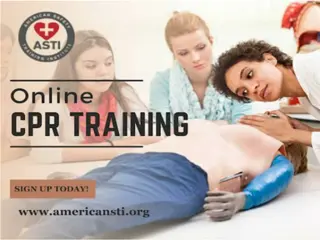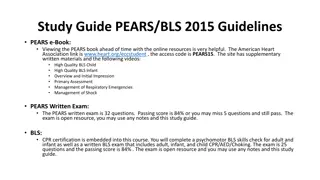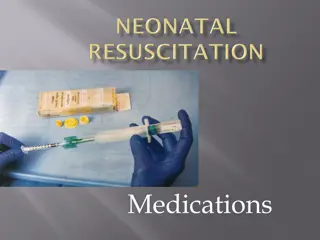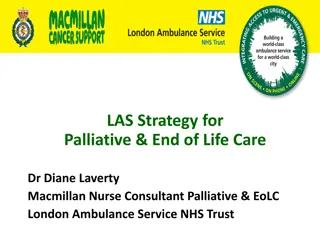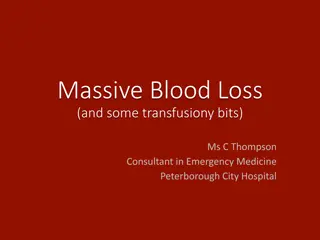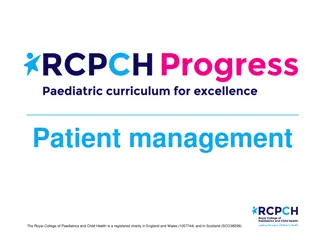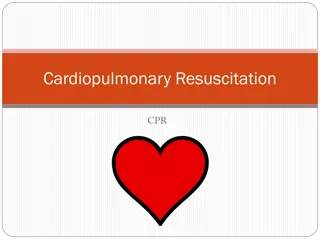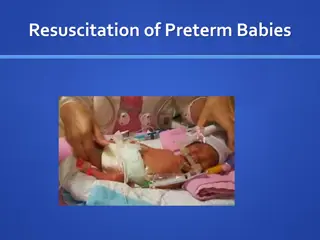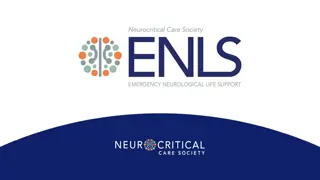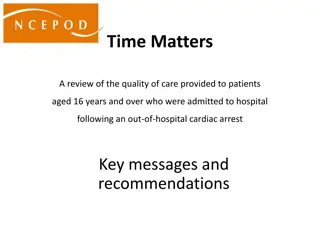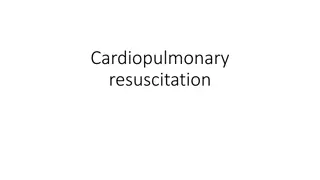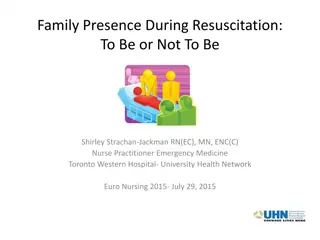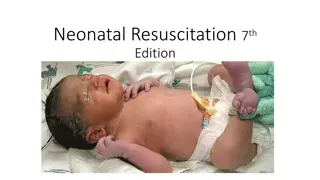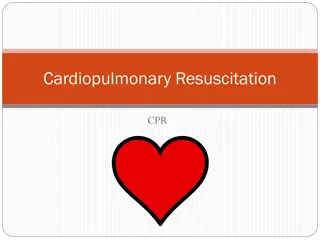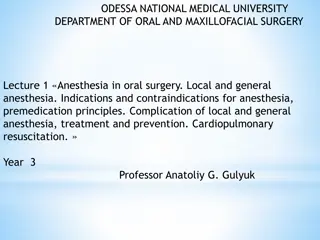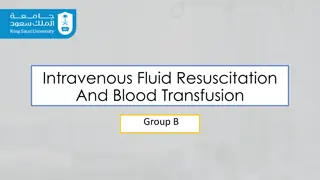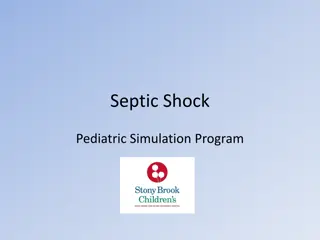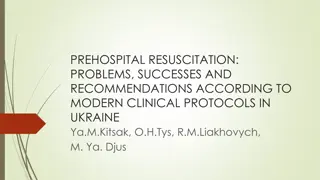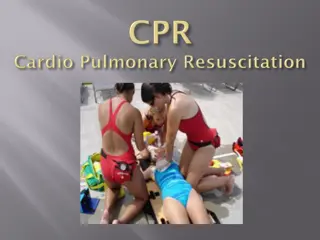Fluid Management in ICU: Understanding Body Fluid Compartments and Types of Fluids
Fluid management in the ICU is crucial for patient care. This includes understanding the distribution of body fluid compartments, such as intravascular, interstitial, and intracellular fluids. Different types of fluids like crystalloids and colloids play essential roles in treatment. Crystalloids ar
3 views • 26 slides
WSI Examiner's Conference 2023 Highlights
Exciting snapshots from the WSI Examiner's Conference 2023 featuring opening addresses, quizzes, updates, practical sessions, and important information on water safety and resuscitation. Dive into educational content and interactive sessions, including insights on the impact of WSI and crucial survi
1 views • 30 slides
Myth-Busting: Common Misconceptions About CPR
When it comes to CPR (Cardiopulmonary Resuscitation), many people are under the impression that it\u2019s only for medical professionals or that it\u2019s too complicated to learn. But these misconceptions can be a matter of life and death.\n\nFor more info visit: \/\/ \/courses.php
1 views • 5 slides
Global Resuscitation Devices Market
\"The Global Resuscitation Devices Market Size is Anticipated to Exceed USD 8.14 Billion by 2033, Growing at a CAGR of 7.42% from 2023 to 2033.\n\"\n
0 views • 5 slides
Pediatric Emergency Assessment and Resuscitation Study Guide
Study Guide for PEARS/BLS 2015 Guidelines covers key topics such as initial assessment, pediatric respiratory emergencies, shock management, and CPR certification. Access online resources and videos for better preparation. Learn about PEARS systematic approach algorithm, hypotensive shock criteria,
0 views • 9 slides
Neonatal Medication Administration and Resuscitation Overview
Neonatal resuscitation may involve administering medications like epinephrine and volume expanders in specific situations such as hypovolemic shock. Before giving medications, ensure proper ventilation and compressions. Epinephrine helps with coronary artery perfusion and oxygen delivery, while volu
1 views • 15 slides
Enhancing Palliative and End-of-Life Care: London Ambulance Service NHS Trust Strategies
London Ambulance Service NHS Trust implements strategies focusing on palliative and end-of-life care, including training ambulance clinicians, making resuscitation decisions, addressing challenges, coordinating care, and administering anticipatory medications. These initiatives aim to improve patien
0 views • 11 slides
Emergency Management of Massive Blood Loss: A Case Study
This case study details the emergency management of a 72-year-old female patient with massive blood loss due to esophageal varices, providing insights into assessment, resuscitation, and treatment strategies to stop bleeding, replace losses, and prevent worsening. Key considerations include the prin
0 views • 31 slides
Enhancing Pediatric Patient Management Practices at The Royal College of Paediatrics and Child Health
The Royal College of Paediatrics and Child Health, a registered charity, focuses on improving patient management through good practices, resuscitation management, and evidence-based medicine. Their curriculum emphasizes assessment, differential diagnosis, treatment planning, and recognition of life-
0 views • 13 slides
Understanding Resurrection According to the New Testament
Exploring the concept of resurrection as outlined in the New Testament, distinguishing it from resuscitation, reanimation, reincarnation, and immortality. Delve into the direction of intention prayer and the Old Testament's perspective on life after death.
0 views • 18 slides
Learn How to Perform Cardiopulmonary Resuscitation (CPR) Steps
Cardiopulmonary Resuscitation (CPR) is a crucial lifesaving technique used in emergencies like heart attacks or near drownings when someone's breathing or heartbeat has stopped. This article provides a detailed guide on performing CPR, including how to check the scene for safety, assess breathing, d
1 views • 9 slides
Understanding and Supporting Premature Babies: Resuscitation and Care
Premature babies are at higher risk of complications due to their physiological vulnerabilities. They require specialized care to maintain body temperature, assist ventilation, manage oxygen levels, and minimize the chances of lung and brain injuries. Learn why preemies face increased risks and disc
0 views • 12 slides
Perioperative Fluid Therapy: Key Concepts and Considerations
Understanding perioperative fluid therapy is crucial for maintaining normovolemia, achieving hemodynamic stability, and preventing complications. Factors such as total body water variation, fluid resuscitation goals, desirable outcomes, and fluid and electrolyte regulation play a critical role in en
3 views • 56 slides
Tactical Medicine Guidelines for Advanced Wound Care
Comprehensive guidelines on advanced wound care in tactical medicine, covering topics such as stopping bleeding early, resuscitation with blood products, tourniquet conversion, lessons learned from combat situations, early irrigation techniques, surgical debridement, and pre-surgical checklists. The
0 views • 16 slides
Emergency Paediatric Tracheostomy Management Algorithm
Emergency Paediatric Tracheostomy Management Algorithm provides a structured approach for managing pediatric patients requiring tracheostomy in emergency situations. The algorithm outlines steps for assessing airway patency, performing suction, and changing the tracheostomy tube if necessary. It emp
0 views • 4 slides
Enhancing Post-Cardiac Arrest Resuscitation Care
Learn about interventions to improve survival and neurological recovery post-cardiac arrest. Discover key aspects of successful post-arrest care and eligibility for interventions reducing brain injury. Includes priorities, clinical cases, prehospital care, stabilization, and identification of treata
0 views • 33 slides
Quality of Care for Patients Following Out-of-Hospital Cardiac Arrest
This review focuses on the quality of care provided to adult patients aged 16 years and older who were admitted to the hospital after experiencing an out-of-hospital cardiac arrest. Key messages highlight the importance of strategies for rapid and high-quality resuscitation, documentation of advance
0 views • 24 slides
Understanding Cardiopulmonary Resuscitation (CPR) and Cardiac Arrest
Cardiopulmonary resuscitation (CPR) is crucial in cases of cardiac arrest, a leading cause of death globally. Immediate recognition of symptoms such as unresponsiveness and abnormal breathing, early activation of emergency services, and prompt initiation of CPR can significantly improve survival rat
0 views • 23 slides
Acute Diabetic Ketoacidosis in a 19-Year-Old Male
Acute presentation of a 19-year-old man with diabetic ketoacidosis (DKA) characterized by hyperglycemia, anion-gap acidosis, and ketosis. Clinical findings include dehydration, hyponatremia, hypotension, altered consciousness, and abdominal pain. Immediate management involves ABCs, fluid resuscitati
0 views • 16 slides
Understanding Family Presence During Resuscitation in the Emergency Department
This presentation explores the lived experiences of families present during cardiopulmonary resuscitation (CPR) in the emergency department, aiming to provide insights that can enhance care for individuals who wish to be by their loved ones' bedside during critical moments. The study focuses on the
0 views • 23 slides
Comprehensive Management of Head Injury: Overview and Key Strategies
Head injuries pose a significant threat to morbidity and mortality, with causes ranging from motor accidents to child abuse and falls. Understanding the epidemiology and pathophysiology of head injuries is crucial for effective management. Primary and secondary brain injuries necessitate immediate c
0 views • 42 slides
Neonatal Resuscitation Guidelines and Protocols
Detailed information on neonatal resuscitation techniques and protocols from the 7th edition guide. Covers topics such as interrupted transitions, resuscitation flow diagram steps, perinatal risk factors, questions to ask before birth, initial steps of newborn care, and more. Emphasizes the importan
0 views • 25 slides
Learn CPR: Cardiopulmonary Resuscitation Steps and Techniques
CPR, or Cardiopulmonary Resuscitation, is a vital technique used in emergencies such as heart attacks or near-drowning incidents where breathing or heartbeat has ceased. This life-saving procedure involves checking the scene for safety, assessing the victim's response, performing chest compressions,
0 views • 11 slides
Importance of CPR in Cardiac Arrest Emergencies
CPR is crucial in cardiac arrest situations as it can prevent brain damage and increase the chance of survival. Knowing how to check for responsiveness and perform CPR correctly on adults, children, and infants can make a difference in saving a life. Immediate action within the first few minutes is
0 views • 10 slides
Overview of Anesthesia in Oral Surgery: Local and General Anesthesia
Anesthesia in oral surgery involves local and general anesthesia, with discussions on indications, contraindications, premedication principles, complications, treatment, prevention, and cardiopulmonary resuscitation. The history of anesthesia in dentistry, from the use of cocaine in 1879 to the deve
0 views • 84 slides
Understanding Intravenous Fluid Resuscitation and Blood Transfusion in Clinical Practice
Intravenous fluid resuscitation and blood transfusion are crucial components of patient care, involving the direct administration of fluids and electrolytes to maintain proper fluid balance. When calculating the volume of fluid to be replaced, various factors must be considered, including maintenanc
0 views • 15 slides
**Understanding Portal Hypertension: Causes, Symptoms, and Treatment**
Portal hypertension is a serious condition often associated with cirrhosis. Causes include cirrhosis and non-cirrhotic conditions. Symptoms range from asymptomatic to complications like variceal hemorrhage, ascites, and splenomegaly. Preventive measures, such as nonselective beta-blockers, are cruci
0 views • 14 slides
Precision Medicine Approach for Post-cardiac Arrest Care Study
Study aims to develop novel biomarkers for optimizing hypothermia duration post-cardiac arrest and predicting 90-day function. Overcoming past limitations in neuroprognostication research, the study utilizes a multicenter approach and standardizes post-resuscitation care protocols. Addressing challe
0 views • 13 slides
Management Strategies for Pediatric Septic Shock Simulation Program
This content provides information on the management of sepsis, including recognition, supportive care, source control, antibiotics, and specific therapies. It emphasizes the importance of initial resuscitation goals, strategies involving fluid resuscitation, inotropic support, and timely administrat
0 views • 12 slides
Management of Lower GI Bleeding: Initial Evaluation and Resuscitation
Lower gastrointestinal bleeding, originating distal to the ligament of Treitz, often presents with overt or occult symptoms. Initial management involves hemodynamic stabilization, localization of the bleed site, and tailored therapeutic interventions. Key steps include IV fluid resuscitation, monito
0 views • 44 slides
Managing Pregnancy-Related Complications: A Comprehensive Overview
Understand the risks and causes of pregnancy-related complications such as resuscitation, DIC, peripartum cardiomyopathy, and more. Learn about management strategies including resuscitation protocols, DIC treatment, and heart failure management. Dive into the prevalence, causes, and treatment of the
0 views • 14 slides
Analysis of Prehospital Resuscitation: Insights from Ukraine's Clinical Protocols
Clinical and statistical analysis of Emergency Medical Dispatch (EMD) teams in Ternopil, Ukraine, from 2018 to 2020 revealed key trends in prehospital resuscitation. The study assessed arrival times, mortality rates, resuscitation measures, and successful outcomes. Challenges and recommendations wer
0 views • 13 slides
Understanding Third Trimester Bleeding: Causes, Evaluation, and Management
Third trimester bleeding can be caused by various factors like placental abruption and previa, requiring prompt evaluation including assessing fetal heart rate and determining placental location. Different complications can arise for both the mother and fetus, necessitating specific management plans
0 views • 17 slides
Comprehensive Guide to Overdose and Poisoning Management
Poisoning and overdose are common occurrences with serious implications. They encompass various toxidromes and require a systematic approach covering risk assessment, resuscitation, investigations, supportive care, decontamination, antidotes, and disposition planning. Recognizing signs of poisoning
0 views • 25 slides
CPR Guidelines and Techniques for Adult, Child, and Infant Resuscitation
CPR, or cardiopulmonary resuscitation, is a life-saving technique performed when someone is unconscious, not breathing, and shows no signs of life. This includes administering chest compressions and breaths in cycles, following specific guidelines for each age group (adult, child, and infant). Prope
0 views • 18 slides
Challenges and Advancements in Burns Care in Malawi
Burns remain a significant public health concern in Malawi, with a high mortality rate, especially among children. Limited knowledge and training in burns care present challenges for nurses in the country. However, through partnerships and specialized training programs, such as Essential Burns Care
0 views • 12 slides


